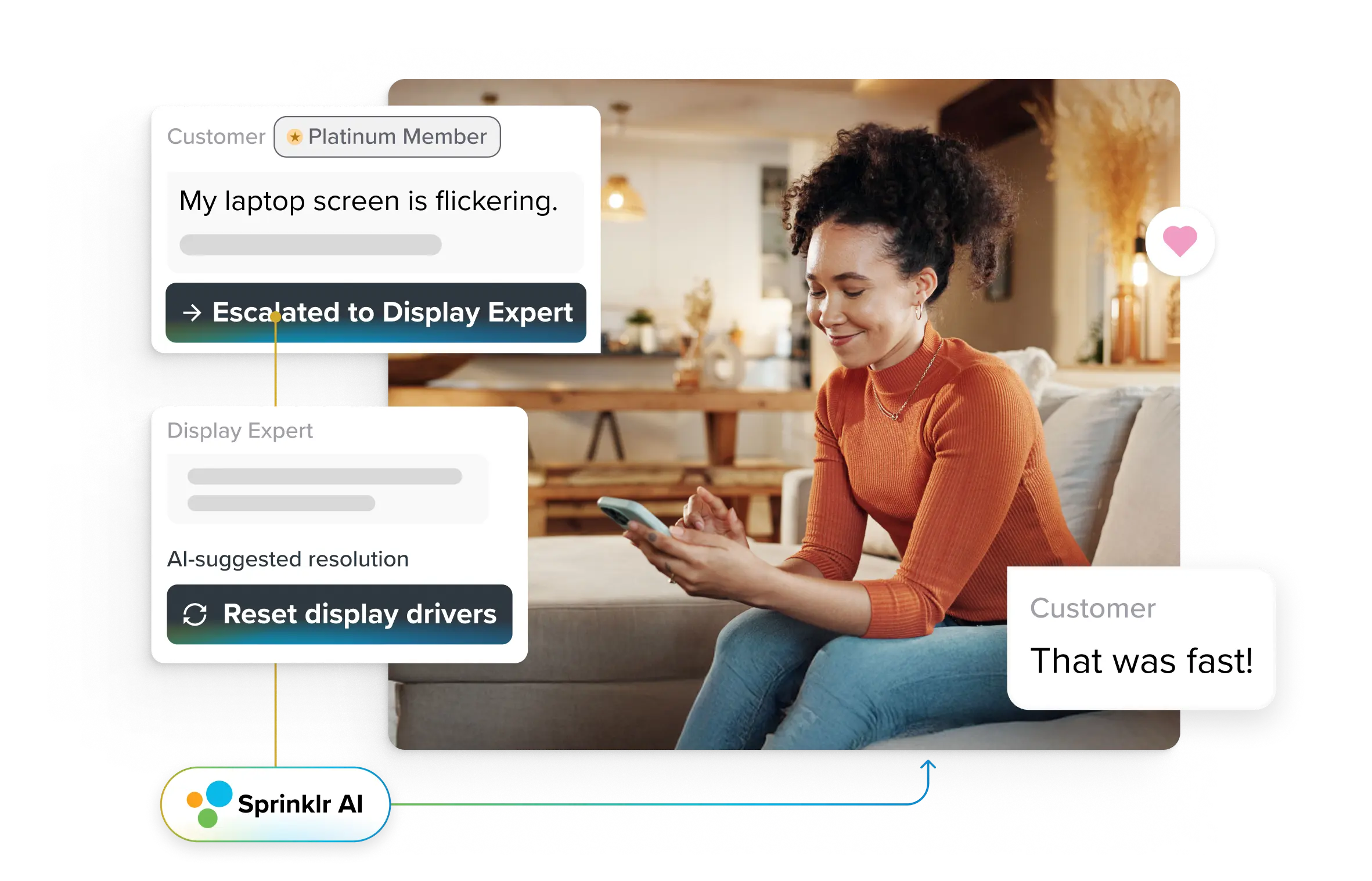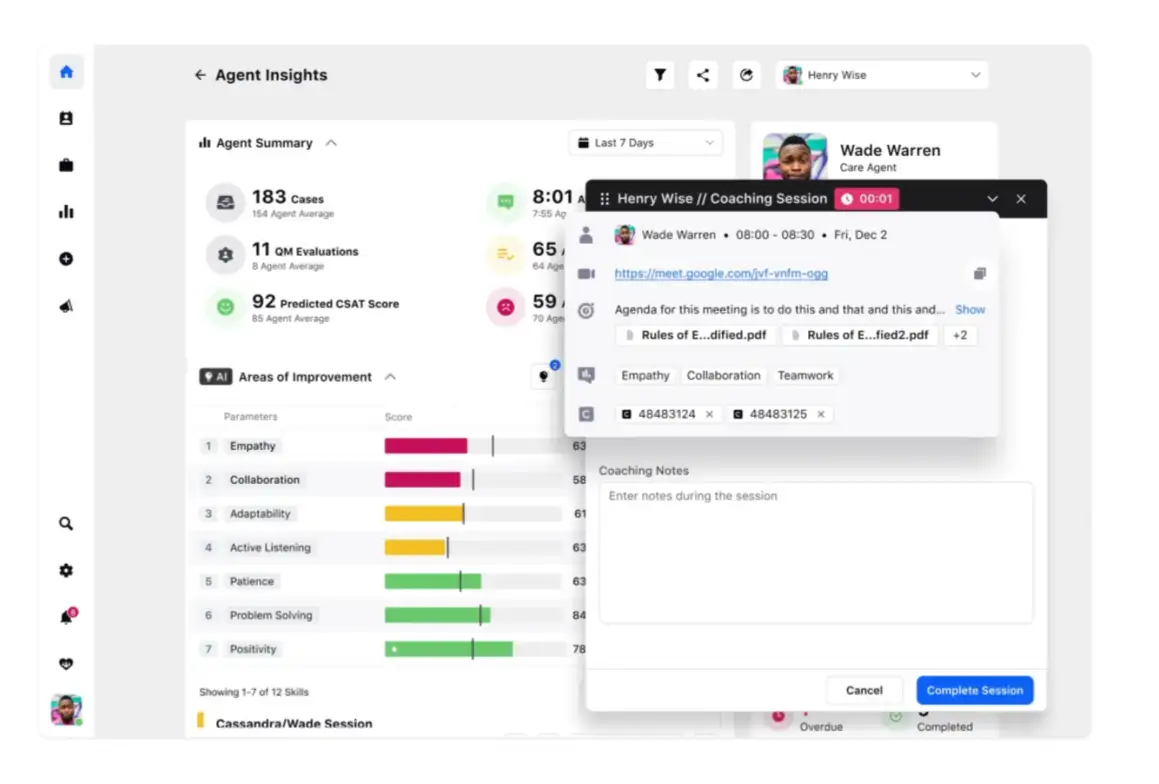Transform CX with AI at the core of every interaction
Unify fragmented interactions across 30+ voice, social and digital channels with an AI-native customer experience platform. Deliver consistent, extraordinary brand experiences at scale.

Contact Center AI in 2025: 7 Trends You Can’t Afford to Ignore
With customers prioritizing service and experience before making purchase decisions, enterprises are racing to modernize the contact center technology stack that powers customer interactions. In 2025, this encompasses a diverse range of traditional voice and digital-first channels, including chat and messaging apps, video platforms, and social media.
To manage these interactions at scale and in a brand-consistent manner, many contact centers are adopting AI in a significant way. Contact center AI (CCAI) refers to a suite of AI-powered capabilities designed to enhance the connection between agents and customers, making every interaction faster, smarter, and easier for both parties.
Consider how several airlines responded during the recent geopolitical unrest in the Middle East. Instead of overwhelming their contact centers, they used AI to deflect routine travel queries to messaging platforms. Only the more complex or emotionally sensitive issues were routed to human agents, allowing faster response times and preserving quality service where it mattered most.
This level of agility reflects the significant progress made by contact centers. But with the arrival of generative AI, the possibilities are expanding even further. Enterprises are now rethinking how contact center AI can streamline every layer of contact center operations, from intelligent routing to predictive analytics.
In this blog, we’ll explore the top contact center AI trends shaping 2025 and what forward-looking leaders should prepare for in 2026 and beyond.
What is contact center AI and why is it at the core of modern CX
Contact center AI is the intelligence layer that powers modern customer service. It's the combination of artificial intelligence technologies such as natural language processing, machine learning, predictive analytics, and generative AI, designed to make enterprise contact centers faster, smarter, and more human.
According to customer service statistics, 80% of American customers say the key to a great experience is a blend of speed, convenience, knowledgeable help, and friendly service. That's the modern standard; across industries and enterprises, delivering on it consistently at scale is no small feat.
Meeting these expectations consistently, across thousands (or millions) of customer interactions, is impossible with legacy systems or manual processes alone. That's exactly where contact center AI steps in, bringing automation, intelligence, and context into day-to-day customer service operations.
Whether it's using AI to predict intent before a customer even reaches an agent, surfacing the right knowledge instantly during a live conversation, or proactively resolving issues through self-service, contact center AI is what enables brands to scale empathy without compromising efficiency.
7 key contact center AI trends to watch in 2025
We’re witnessing a decisive shift, from scattered AI pilots to enterprise-wide, AI-first transformations. Business leaders are no longer debating whether they should use AI in contact centers; the question now is how quickly and strategically they can scale it. The trends below reflect that momentum, and where the future is clearly headed.
Trend #1: AI-first agent assist goes real-time and context-aware
🎯Focal point: Reduced average handling time (AHT) and quicker after-call work (ACW).
One of the most significant shifts in contact centers over the past few years has been the transformation of agent assist — from passive, rules-based tools to real-time, context-aware AI copilots. These modern systems actively listen to live conversations, interpret customer intent, and surface relevant insights, suggested responses, and next-best actions — all as the interaction unfolds.
This marks a clear departure from earlier assist tools that relied on static knowledge bases or manual queries, often requiring agents to dig for answers mid-call. Now, with generative AI and advanced language models becoming enterprise-ready, agent assist tools are evolving into true copilots, lightening cognitive load and freeing agents to stay fully engaged with the customer.
And the urgency to adopt this tech is growing.
According to McKinsey, 57% of customer care leaders expect call volumes to rise over the next one to two years, making AI-powered agent assist software a strategic necessity. For enterprise contact centers under pressure to manage scale while preserving service quality, this is no longer optional.
Modern agent-assist platforms do more than suggest answers. They optimize agent responses for tone, accuracy, and context, extract information directly from knowledge bases, and even automate post-call actions, such as summarization and disposition. As a result, interactions become more focused, average handle times remain low, and after-call workload is significantly reduced.
Trend #2: Generative AI is redefining self-service from scripted to smart
🎯 Focal point: Higher self-service containment, reduced pressure on live agents.
For years, self-service in contact centers meant static FAQs, rigid IVRs, and chatbot workflows that followed pre-defined trees. But now, generative AI has begun to fundamentally reshape self-service, turning it from a channel of containment into a true first line of resolution — intelligent, conversational, and context-aware.
Today’s leading contact centers are moving beyond scripted bots and deploying LLM-powered virtual agents that can understand nuanced intent, handle multi-turn conversations, pull information from real-time data sources, and even personalize responses based on past interactions.
By handling more complex Tier 1 and Tier 2 issues through conversational AI, enterprises are freeing up human agents for higher-value interactions, while also delivering faster resolutions around the clock.
📌 Worth noting
Gartner predicts that by 2026, conversational AI deployments in contact centers will reduce agent labor costs by $80 billion globally.
The direction is clear: static self-service is being replaced by adaptive, brand-aligned AI assistants trained on enterprise-grade data and fine-tuned for modern customer expectations. In addition to reducing costs, this approach helps you scale intelligent customer experiences without the need to expand your teams.
Trend #3: Predictive and AI-optimized routing is replacing static call flows
🎯 Focal point: Higher first-contact resolution and lower transfer rates through intelligent, intent-based routing.
Traditional call routing, based on IVR inputs or simple skill-based logic, is fast becoming obsolete in large-scale, high-volume contact centers. In 2025, AI-driven predictive routing is emerging as a strategic differentiator, matching customers with the best available resource based not just on availability or skill, but also on intent, sentiment, historical behavior, and the likelihood of a positive outcome.
Instead of funneling customers through static menus (“Press 1 for billing, 2 for support”), AI systems now analyze signals in real time, such as past interactions, transaction history, or even behavioral data, to infer intent before a word is spoken. This approach leads to faster resolutions, fewer transfers, improved first-contact resolution, and more personalized, emotionally intelligent experiences.
⛳ On the ground
In 2024, Verizon used generative AI to prevent 100,000 customers from churning. With over 170 million calls received each year, Verizon’s AI models now accurately determine the reason for a customer’s call 80% of the time. According to CEO Hans Vestberg:
"I have 60,000 call agents, and I know what they are really good at—so I can match your call with the right agent." (Source: Reuters)
That precise, AI-powered matchmaking is already changing the game, turning customer service from reactive firefighting into proactive value delivery.
Trend #4: Comprehensive contact center quality management with a unified AI layer
🎯 Focal point: Scalable QA with consistent scoring, real-time coaching, and compliance assurance.
For most contact centers, quality management has long been defined by limitations — manual call sampling, subjective scoring, siloed systems, and delayed feedback loops. But in 2025, that’s no longer sustainable. As customer interactions grow in volume and complexity, traditional contact center quality management practices can’t keep pace. That’s where contact center AI, layered intelligently across systems, is stepping in.
By unifying interaction data across voice, live chat, email, and social, AI now enables QA teams to automatically evaluate every customer conversation, not just a select few. This includes assessing customer sentiment shifts, tone of voice, compliance adherence, and even whether the agent followed through on next steps. All in near real time.
Rather than QA being a backend task disconnected from operations, a unified AI layer brings quality insights into the contact center workflow, helping supervisors coach in the moment, not after the fact.
💡Key takeaway
With the right AI foundation, QA becomes less about auditing and more about enabling consistent performance and proactive improvement at scale.
Sprinklr’s AI-powered quality management software brings this vision to life for enterprise-grade contact centers. It evaluates 100% of interactions across channels, analyzing transcripts and audio files with high accuracy using Sprinklr AI. With multimodal analysis, it delivers context-rich, unbiased scores and provides an explanation for the reasoning behind each evaluation.
More importantly, it turns insights into action: identifying agent-specific skill gaps, recommending tailored coaching modules, assigning training sessions, and tracking progress over time. The result is a continuous quality loop that’s embedded into daily operations, not tacked on as an afterthought.

Trend #5: Proactive service with predictive contact center AI
🎯 Focal point: Lower inbound volume and reduced churn through preemptive, AI-led customer outreach.
While traditional contact centers have focused on responding efficiently, the next frontier is predicting what customers need before they reach out. In 2025, leading enterprises are shifting from reactive support to proactive customer service, using contact center AI to forecast issues, anticipate intent, and take preemptive action.
Here’s how it plays out:
- Behavioral patterns and interaction history help AI identify when a customer is likely to escalate or encounter an issue, even if they haven’t yet contacted support.
- Integration with CRM and product systems enables AI to detect triggers, such as a failed payment, a shipping delay, or a product malfunction, and automatically provide resolutions.
- Real-time intent prediction models power proactive outbound messaging across channels like SMS, WhatsApp, and email, reducing inbound volume and improving customer experience simultaneously.
Must Read: Predictive Analytics – The Next Big Thing in Customer Service
Trend #6: Smarter contact center workforce management with AI-driven forecasting and real-time control
🎯 Focal point: Improved agent utilization and service levels through accurate forecasting
Workforce management has long been a critical pillar of contact center success, but in 2025, AI is providing it with a much-needed upgrade. Gone are the days of static forecasts, clunky schedules, and delayed adherence reports. Today’s contact center AI is reshaping workforce operations with real-time data, predictive intelligence, and automated decision-making, enabling managers to respond as dynamically as customer demand itself.
Here’s what that shift looks like:
- AI-powered forecasting draws on historical interaction data, external events, seasonal trends, and marketing calendars, generating highly accurate demand predictions across various channels.
- Smart capacity planning maps workforce supply to expected demand, factoring in agent skill sets, availability, and time-off requests — helping leaders avoid both overstaffing and burnout.
- Real-time agent adherence tracking monitors schedules in real-time, flags deviations instantly, and provides supervisors with visibility to act quickly, rather than waiting for post-shift reports.
- Intraday reforecasting and auto-scheduling ensure the operation adapts in real time, whether there’s a spike in volumes, a system outage, or an unexpected drop in agent availability.

Trend #7: Rise of agentic AI in contact centers
🎯 Focal Point: Autonomous task execution and reduced agent workload through intelligent decision-making.
Until now, most AI in contact centers has worked in assistive mode — guiding agents, surfacing suggestions, or analyzing past data to inform decisions. But 2025 marks a shift toward something more autonomous: agentic AI.
Agentic AI refers to systems that can reason, plan, and act independently toward a defined goal, within enterprise-approved guardrails. In the context of contact centers, this means AI that doesn’t just assist an agent; it can be the agent, handling complex customer service workflows across channels without human intervention.
Think beyond basic chatbots. Agentic AI can initiate conversations, ask clarifying questions, retrieve data from backend systems, update customer records, escalate only when needed, and even resolve end-to-end service requests — all while learning and adapting from each interaction.
This isn’t theoretical. Enterprises are already piloting agentic AI to:
- Automate Tier-1 support across voice and digital channels
- Follow multi-step resolution workflows for billing or service changes
- Act as a 24/7 backup for human agents during spikes or off-hours
- Handle backend tasks like updating CRMs or initiating refunds post-call
💡 Editor’s Pick: Agentic AI vs. Traditional AI: Key Differences, Use Cases, and Adoption Framework
How to build a business case for AI in contact centers
Believe it or not, a compelling business case for AI in contact centers doesn’t begin with technology. It starts with business imperatives. And in 2025, those imperatives are clear: control costs, protect margins, grow customer lifetime value, and do more with less.
For decades, the contact center has been viewed as a necessary cost center, essential for service, but rarely seen as a driver of growth. AI changes that equation. It repositions the contact center as a proactive, intelligent front door to your enterprise, capable of anticipating customer needs, resolving issues more efficiently, and even driving revenue growth. But to unlock that potential, the C-suite must see the investment not as a tech upgrade, but as a strategic advantage.
Let’s break this down through a simple lens the boardroom understands: a three-part impact matrix — Revenue, cost, and risk.
Revenue.
AI-native contact centers now serve as dynamic enablers of sales and customer service. Intelligent agent assistance tools recommend next-best actions in real-time, allowing reps to upsell, cross-sell, or retain customers with contextual precision. Predictive outreach — powered by real-time intent modeling — lets you reach customers before they churn, even before they complain.
Enterprises leading in AI adoption are already seeing an increase in conversion rates, lower churn, and higher net promoter scores, all of which contribute to a meaningful revenue impact.
Cost.
Here is where CFOs lean in. With AI, contact centers no longer need to scale headcount linearly with call volume. An intelligent virtual agent can now deflect thousands of queries per hour with near-human fluency. Real-time transcription, automated quality scoring, and agent performance insights slash the cost of traditional QA and training cycles. Forecasting tools that once relied on historical averages can now adapt in real time to volume fluctuations, ensuring optimal staffing with minimal overages. As a result, you unlock lower cost per contact, reduced overtime, and better resource utilization.
📌 Good Read: How to Calculate Contact Center ROI
Risk.
For CEOs and compliance officers, the contact center is a reputational minefield. One misstep, one unresolved issue that goes viral, can cost more than a year's worth of ad spend. AI mitigates this by monitoring every conversation, flagging compliance risks in real-time, and ensuring that every interaction — whether voice or digital — is aligned with brand and legal standards. Moreover, predictive systems surface patterns early. When customer sentiment drops or frustration spikes, leaders can intervene before small issues become systemic.
These aren't siloed wins — they reinforce each other. Lower costs free up resources to invest in better experiences. Better experiences drive customer retention and advocacy. Stronger governance reduces volatility and protects the brand.
📂 From the Vault: The Ultimate Guide to Enterprise Risk Management
The future of contact centers isn’t AI-assisted. It’s AI-accelerated.
As customer expectations surge and operational complexity multiplies, enterprise leaders can no longer rely on incremental improvements. What’s needed now is a complete rethinking of how people, processes, and platforms come together through the power of AI.
From predictive routing and proactive service to real-time agent assist and AI-powered workforce management, the message is clear: AI is not just enhancing contact centers; it’s redefining them. But not all AI is created equal. Point solutions lead to fragmentation. Poorly integrated tools slow down transformation. What today’s enterprise demands is a unified, contextual, and scalable contact center AI strategy from the outset.
That’s where Sprinklr Service stands apart.
Built on the world’s only Unified-CXM platform, Sprinklr Service brings together generative AI, true omnichannel engagement, and a unified agent desktop — all on a single architecture.
Whether you’re looking to automate high-volume queries, empower agents with real-time intelligence, or forecast and optimize your workforce with precision, Sprinklr enables you to modernize every layer of your contact center operation.
👉 Book a demo with our experts and explore what’s possible with Sprinklr Service.
Frequently Asked Questions
AI helps streamline workflows, automate repetitive tasks and deliver faster, more personalized responses. This improves both customer satisfaction and agent productivity while reducing operational costs.
Generative AI is powering real-time summarization, auto-responses and agent assist. Predictive models are also being used for churn prevention, intelligent routing and proactive engagement at scale.
Yes, AI helps unify conversations across voice, chat, email and social channels. It maintains context across interactions, allowing for a seamless and consistent customer experience.
Key metrics include first contact resolution, average handle time, customer satisfaction, net promoter score and agent efficiency. These help you gauge both service quality and ROI.
Start with clear governance, data quality controls and compliance frameworks. Involve IT, legal and CX teams early to ensure ethical, secure and scalable AI deployment across regions.










